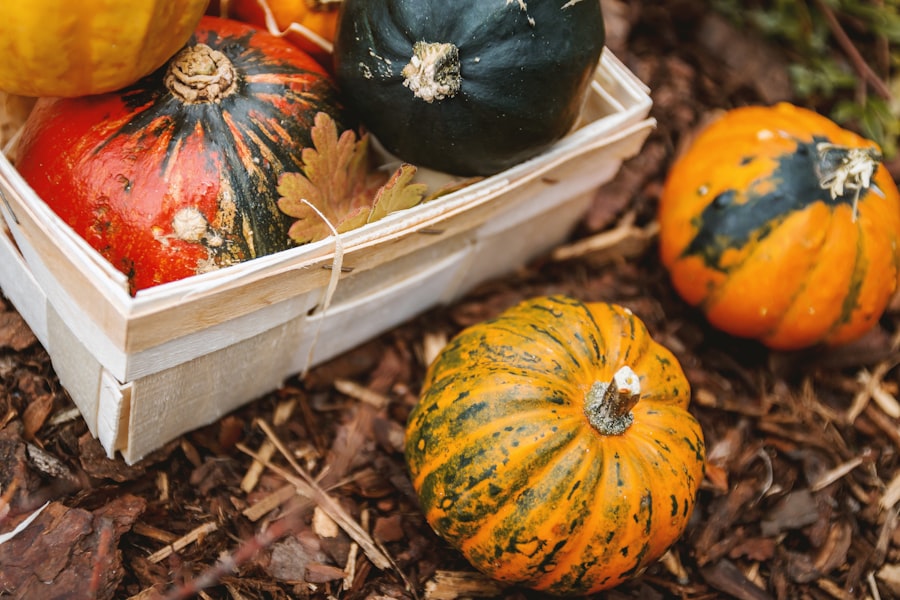Freezing Butternut Squash: How-To Guide

Butternut squash is a versatile and nutritious vegetable that is enjoyed by many people around the world. It is packed with vitamins, minerals, and fiber, making it a healthy addition to any diet. However, butternut squash has a relatively short shelf life and can spoil quickly if not stored properly. Freezing butternut squash is a great way to extend its lifespan and ensure that you always have this delicious vegetable on hand.
Key Takeaways
- Freezing butternut squash is a great way to preserve it for later use.
- Preparing butternut squash for freezing involves peeling, seeding, and cutting it into desired sizes.
- Blanching butternut squash helps to preserve its color, texture, and flavor.
- After blanching, it is important to cool and drain the butternut squash before packaging it for freezing.
- Proper labeling and storage of frozen butternut squash is crucial for easy identification and safe consumption.
Why Freeze Butternut Squash?
There are several advantages to freezing butternut squash. Firstly, it allows you to enjoy this vegetable all year round, even when it is out of season. By freezing butternut squash when it is in abundance, you can save money and have access to it whenever you need it. Secondly, freezing butternut squash helps to preserve its nutritional value. The freezing process locks in the vitamins and minerals, ensuring that they are not lost over time. Lastly, freezing butternut squash is a convenient way to have it readily available for cooking. It eliminates the need for frequent trips to the grocery store and allows you to easily incorporate this nutritious vegetable into your meals.
When comparing fresh vs. frozen butternut squash, there are a few factors to consider. Fresh butternut squash has a vibrant color and a slightly sweeter taste compared to its frozen counterpart. However, fresh butternut squash has a shorter shelf life and requires more frequent trips to the grocery store. On the other hand, frozen butternut squash retains its nutritional value and can be stored for several months without spoiling. While the texture may be slightly different after freezing, it is still delicious and can be used in a variety of recipes.
Preparing Butternut Squash for Freezing
Before freezing butternut squash, it is important to properly prepare it. Start by selecting a ripe and firm butternut squash. Look for one that is heavy for its size and has a smooth, unblemished skin. Avoid squash that has soft spots or mold. Once you have chosen the perfect butternut squash, wash it thoroughly under running water to remove any dirt or debris.
To prepare the butternut squash for freezing, begin by cutting off the stem and the bottom of the squash. Then, use a sharp knife to carefully peel off the skin. Once the skin is removed, cut the squash in half lengthwise and scoop out the seeds and pulp using a spoon. Cut the squash into cubes or slices, depending on your preference. It is important to note that larger pieces may take longer to cook when thawed.
Blanching Butternut Squash
| Metric | Value |
|---|---|
| Butternut Squash Weight | 1 lb |
| Water Temperature | 212°F |
| Blanching Time | 2 minutes |
| Drain Time | 1 minute |
| Ice Bath Time | 3 minutes |
| Final Product Weight | 0.8 lb |
Blanching is an important step in the freezing process as it helps to preserve the color, texture, and flavor of the butternut squash. Blanching involves briefly boiling the vegetable and then immediately transferring it to an ice bath to stop the cooking process.
To blanch butternut squash, bring a large pot of water to a boil. Carefully add the prepared squash to the boiling water and let it cook for 2-3 minutes. The exact cooking time may vary depending on the size of the pieces. After blanching, quickly remove the squash from the boiling water using a slotted spoon or tongs and transfer it to a bowl filled with ice water. Let it sit in the ice bath for 2-3 minutes to cool down completely.
Cooling and Draining Butternut Squash
After blanching, it is important to properly cool and drain the butternut squash before packaging it for freezing. Cooling the squash helps to stop the cooking process and prevent it from becoming mushy. Draining removes any excess moisture that could lead to freezer burn.
To cool the butternut squash, remove it from the ice bath and spread it out on a clean kitchen towel or paper towels. Pat the squash dry to remove any excess moisture. Let it sit at room temperature for about 10-15 minutes to cool down completely.
Packaging Butternut Squash for Freezing

There are several packaging options for freezing butternut squash. One option is to use freezer-safe plastic bags. Place the cooled and drained butternut squash into the bags, making sure to remove as much air as possible before sealing them. Another option is to use airtight containers or freezer-safe glass jars. Fill the containers with the cooled and drained butternut squash, leaving about an inch of headspace to allow for expansion during freezing. Seal the containers tightly.
It is important to label the packaging with the date of freezing and the contents. This will help you keep track of how long the butternut squash has been in the freezer and ensure that you use it before it loses its quality.
Labeling and Storing Butternut Squash
Labeling and storing butternut squash properly is crucial to maintaining its quality in the freezer. Use a permanent marker to write the date of freezing and the contents on the packaging. This will help you keep track of how long the butternut squash has been in the freezer and ensure that you use it before it loses its quality.
When storing butternut squash in the freezer, it is important to keep it in a consistently cold environment. The ideal temperature for freezing butternut squash is 0°F (-18°C) or below. Make sure that your freezer is set to this temperature and avoid opening it frequently to maintain a stable temperature.
Thawing Frozen Butternut Squash
When you are ready to use the frozen butternut squash, there are several methods for thawing it. The best method depends on how quickly you need to use the squash and the recipe you are planning to make.
One method is to thaw the butternut squash in the refrigerator. Simply transfer the frozen squash from the freezer to the refrigerator and let it thaw overnight. This method is the slowest but results in the best texture and flavor.
Another method is to thaw the butternut squash in cold water. Place the frozen squash in a sealed plastic bag and submerge it in a bowl of cold water. Change the water every 30 minutes until the squash is thawed. This method is faster than thawing in the refrigerator but requires more attention.
If you need to use the butternut squash immediately, you can also cook it directly from frozen. Simply add the frozen squash to your recipe and adjust the cooking time accordingly. Keep in mind that cooking times may be slightly longer when using frozen squash.
Cooking with Frozen Butternut Squash
Frozen butternut squash can be used in a variety of recipes, making it a versatile ingredient to have on hand. It can be added to soups, stews, casseroles, and even used as a side dish or a filling for pies and pastries.
When using frozen butternut squash in recipes, there are a few tips to keep in mind. Firstly, adjust the cooking time accordingly as frozen squash may take longer to cook than fresh squash. Secondly, be mindful of the texture of the squash after thawing. It may be slightly softer than fresh squash, but this should not affect the overall taste of your dish. Lastly, season your recipes well as freezing can sometimes dull the flavors of ingredients.
Tips and Tricks for Freezing Butternut Squash Successfully
To ensure successful freezing of butternut squash, here are some additional tips and tricks:
1. Use high-quality freezer bags or containers that are specifically designed for freezing. This will help to prevent freezer burn and maintain the quality of the squash.
2. Remove as much air as possible from the packaging before sealing it. This will help to prevent freezer burn and maintain the texture of the squash.
3. Freeze butternut squash in small portions that you are likely to use in one go. This will make it easier to thaw and use without wasting any leftovers.
4. Blanching is an important step in the freezing process as it helps to preserve the color, texture, and flavor of the butternut squash. Do not skip this step.
5. When thawing frozen butternut squash, avoid using hot water or microwaving it directly as this can cause uneven thawing and affect the texture of the squash.
Freezing butternut squash is a great way to extend its shelf life and ensure that you always have this nutritious vegetable on hand. By properly preparing, blanching, cooling, and packaging the squash, you can maintain its quality and enjoy it all year round. Whether you choose to thaw it in the refrigerator, in cold water, or cook it directly from frozen, frozen butternut squash can be used in a variety of recipes. With these tips and tricks, you can successfully freeze butternut squash and enjoy its deliciousness whenever you desire.
If you’re wondering how to freeze butternut squash, you might find this article on Lawn World’s website helpful. It provides step-by-step instructions and tips on properly freezing butternut squash to preserve its flavor and texture. Check out the article here for all the details you need to know.
FAQs
What is butternut squash?
Butternut squash is a type of winter squash that has a sweet, nutty flavor and a creamy texture. It is commonly used in soups, stews, and casseroles.
Why would I want to freeze butternut squash?
Freezing butternut squash is a great way to preserve it for later use. It can be frozen in cubes or pureed for use in soups, stews, and other recipes.
How do I prepare butternut squash for freezing?
To prepare butternut squash for freezing, start by washing and peeling the squash. Cut it into cubes or puree it in a food processor. Blanch the squash by boiling it for 2-3 minutes, then immediately transfer it to an ice bath to stop the cooking process.
How do I store butternut squash in the freezer?
Once the butternut squash has been blanched and cooled, transfer it to a freezer-safe container or bag. Label the container with the date and contents, then store it in the freezer for up to 6 months.
How do I thaw frozen butternut squash?
To thaw frozen butternut squash, remove it from the freezer and let it thaw in the refrigerator overnight. Alternatively, you can thaw it in the microwave or by placing the container in a bowl of cold water.



